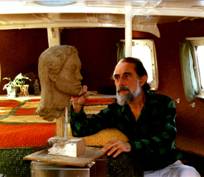LEO CAPPEL

Sculpting in the aft cabin of our yacht. Bigger work in metal or marble was done on the aft deck, where I had a small gas kiln as well, securely bolted down through the deck beams and protected by a heavy wooden box when we were sailing.
My earliest memory is of my grandmother teaching me how to say cigar in Dutch ('sigaar', I was born in Amsterdam). Words intrigued me then, and have done so ever since. Words, sounds and patterns - read: writing, music and sculpting, my three art forms.
During the war I had to hide with a family in Friesland. The adults spoke Dutch as well, the few kids I befriended spoke nothing but Friesian. After the war the Red Cross sent me to Switzerland, to live with elderly foster parents, who spoke only Swiss-German. The Dutch word Papa became Heit in Friesian, Vater in Switzerland. Later still, when I was an art student in Paris for one semester, it was Père and now it's Dad. How could I not be fascinated?
In many ways the war years were horrible, but the willingness with which the people who had been hiding me had ignored the danger, has helped shape my personality.
I studied art at the Rietveld Academy, Amsterdam. I worked as an art teacher, as industrial designer and as scuba diving instructor before emigrating to New Zealand.
One of my first jobs in New Zealand was with the railways, as 'relay mechanic'. My English was still rather shaky and my off-sider came from the top of Scotland!
A few months later I was offered a position at the Canterbury Museum, to make small diorama displays - mainly for country schools - and after 4 years I found myself creating the very large dioramas in the Auckland Museum.
My wife Karen and I got restless, decided to build a 54 foot yacht, It took 7 years of weekends and holidays, financed by sculpting, painting, writing, performing and directing on stage, playing music, and building unusual musical instruments in what little spare time we could find.
We lived aboard, getting ready to travel overseas. Then a bombshell: the asbestos in my lungs - legacy of my work at the Auckland War Memorial Museum! - began to play up, no more ocean sailing after all. My response: to write a cheerful novel, SAIL THEATRE, SAIL, followed by several stage plays and musicals, five of which have been produced, and the novel CLONE.
After 16 years aboard, often in Whangarei, we lived for another 10 years on top of a hill on tiny Kawau Island, where there are no shops, no roads, no rubbish removal or any other services apart from electricity - most of the time - and telephone, and where we got our mail delivered by the Royal Mail Run ferry twice a week. There I could dig modelling clay straight out off the garden, and collect fallen kanuka trees in the bush, to fire the large wood-kiln for my sculpting.
And now, several art exhibitions and 7 literary awards and prizes later, we have moved to Whangarei, not far from where Linda and Jenny would have lived, if they had been real people instead of imaginary friends of mine, living in my novel CLONE.
Leo Cappèl